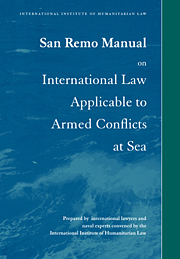 San Remo Manual on International Law Applicable to Armed Conflicts at Sea
San Remo Manual on International Law Applicable to Armed Conflicts at Sea Book contents
- Frontmatter
- Contents
- FOREWORD
- SAN REMO MANUAL
- Introductory note
- Part I General provisions
- Part II Regions of operations
- Part III Basic rules and target discrimination
- Part IV Methods and means of warfare at sea
- Part V Measures short of attack: interception, visit, search, diversion and capture
- Part VI Protected persons, medical transports and medical aircraft
- Annex: Series of meetings and contributions to the project
- EXPLANATION
- INDEX
Part I - General provisions
Published online by Cambridge University Press: 04 August 2010
- Frontmatter
- Contents
- FOREWORD
- SAN REMO MANUAL
- Introductory note
- Part I General provisions
- Part II Regions of operations
- Part III Basic rules and target discrimination
- Part IV Methods and means of warfare at sea
- Part V Measures short of attack: interception, visit, search, diversion and capture
- Part VI Protected persons, medical transports and medical aircraft
- Annex: Series of meetings and contributions to the project
- EXPLANATION
- INDEX
Summary
Section I Scope of application of the law
1 The parties to an armed conflict at sea are bound by the principles and rules of international humanitarian law from the moment armed force is used.
2 In cases not covered by this document or by international agreements, civilians and combatants remain under the protection and authority of the principles of international law derived from established custom, from the principles of humanity and from the dictates of the public conscience.
Section II Armed conflicts and the law of self-defence
3 The exercise of the right of individual or collective self-defence recognised in Article 51 of the Charter of the United Nations is subject to the conditions and limitations laid down in the Charter, and arising from general international law, including in particular the principles of necessity and proportionality.
4 The principles of necessity and proportionality apply equally to armed conflict at sea and require that the conduct of hostilities by a State should not exceed the degree and kind of force, not otherwise prohibited by the law of armed conflict, required to repel an armed attack against it and to restore its security.
5 How far a State is justified in its military actions against the enemy will depend upon the intensity and scale of the armed attack for which the enemy is responsible and the gravity of the threat posed.
- Type
- Chapter
- Information
- San Remo Manual on International Law Applicable to Armed Conflicts at SeaInternational Institute of Humanitarian Law, pp. 7 - 10Publisher: Cambridge University PressPrint publication year: 1995


